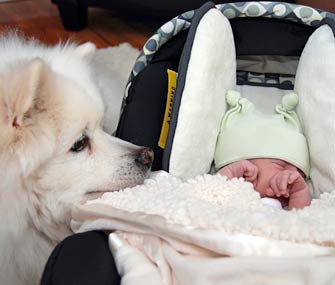
As a mother of three, I am well acquainted with that wonderful feeling that is discovering that you’re going to be a mom (or dad) for the first time. I am also intimately familiar with the feeling of utter panic that sets in along the way. For me, my animals’ adjustment to the new baby was just as important as my own and was a definite source of angst. My Australian Cattle Dog, Bentley, was 3 years old at the time, and that particular breed is not known for their love of children. I read many books and google-ed many topics and largely made myself more anxious than I’d previously been. To top off that concern, I had my “cat-o-phobic” family urging me to get rid of our beloved cat, Luthien, because it was a foregone conclusion that she would suffocate the baby (out of spite!) in his/her sleep.
I decided to save myself further mental anguish and use my common sense to reason through this situation. First, I got Bentley a dog. In retrospect, though we love her dearly, I don’t know that this is my top recommendation. Nessa is our Golden Retriever and she is cherished by the kids and is the sort of dog who loves to be touched, even if its pulled ears and being straddled and instructed to “go horsie”. I don’t for a moment regret getting her, but I caution you to think hard before you go from a one- to two-dog household right before you add an additional human to the mix. In my case, the dynamics of adding Nessa to the home worked out swimmingly, but that isn’t always the case. The last thing a pregnant woman needs (and trust me, I know) is additional stress.
In order to prepare the furry children, I acquired a little doll that we practiced cloth diapering on and carried it around to help them get used to us not being readily available. In addition, we set up the nursery and all the fancy swings and things to get the animals used to the environmental changes ahead of time. Enough change is coming, better to stage it along the way. Why else is human gestation nine months if not to prepare the household pets (not to mention the parents)?
Its a good idea to set up “off-limits” zones prior to the baby’s arrival so that, again, you’re minimizing the changes that take place suddenly. For instance, we got Bentley and Nessa used to not being allowed to wander into the nursery without supervision with both a baby gate and a closed door. You can also set up areas that will eventually be off-limits to the baby that can act as a “safe zone” for your pets. Everyone needs an escape from time to time, Fido included.
Additionally, it’ll be some time before your infant becomes mobile, but to get your pets used to the gates (as well as your shins), I recommend putting up baby gates well ahead of a crawling baby.
I will say, time has passed and my belief that most (of course there are many exceptions) average dogs can adjust and accept the child as it grows through its many stages. I think the important things to remember when adjusting to a new baby with pets are these: children are frightening. They’re small, loud and mostly unpredictable. Be patient with your pet, but don’t trust them too much with the kids. Your time is about to become drastically more limited; make real efforts to get the dogs out to expend that pent up energy as much as you can as well as block off quality time (even if its just 5-10 minutes) each day to spend with your pets.
At this point, my oldest is five and my youngest is four months. Bentley actually lowers his head to accept a pat from Noah (Rowan’s still a little unpredictable to approach willingly,) and loves to play ball and frisbee with the kids. It didn’t happen overnight; most worthwhile things require time and energy! Please don’t hesitate to call and pick my brain for ideas to help your unique pet adjust to the new family member!
For more great advice check out the Behavior Newsletter from The Ohio State College of Veterinary Medicine. http://vet.osu.edu/sites/default/files/documents/pdf/news/behaviorNewsletter/BehaviorNewsIssue7.pdf
